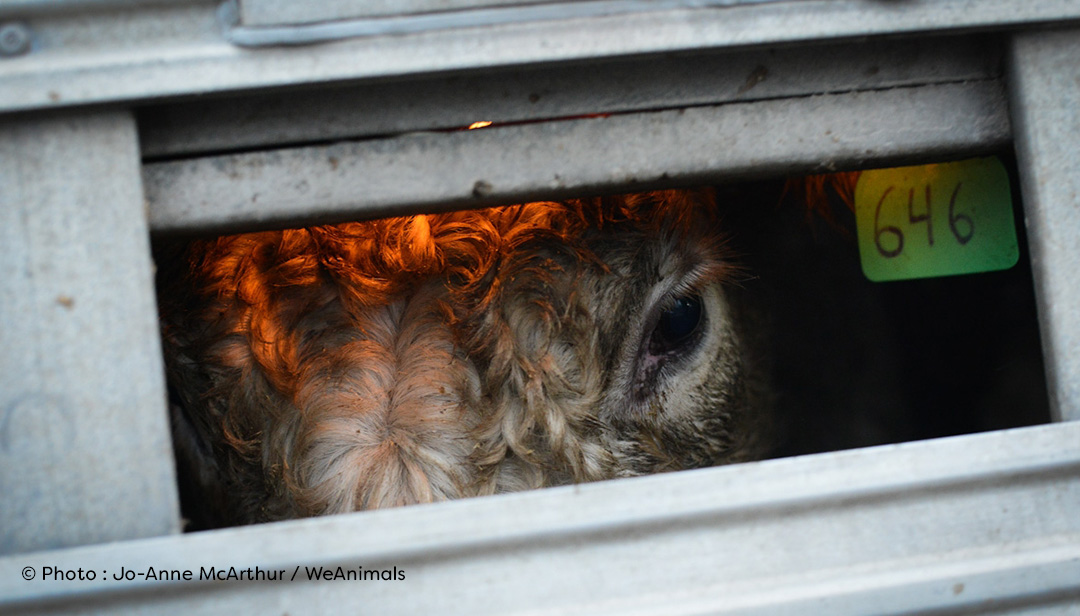We’ve all been there. Stuck in traffic on the highway listening to Baby one more time or some other embarrassing song, when a massive, dirty, grey truck with perforated sides slowly pulls up into the lane next to us. Pressed up against the oval-shaped openings, pink snouts try to get a whiff of what lies ahead. Widened eyes stare out in bewilderment. We know all too well where these animals are ultimately headed – and perhaps that’s why we try not to meet their inquiring gaze – but what do we really know about their journey?
Annually across Canada, 700 million farm animals are transported from farm to slaughter. Nearly 2 million of these animals die during the transport process, and an estimated 12 million more are injured or become ill. We have laws that govern how animals are to be treated during transport, but they are over 40 years old and are considered by experts to be the worst in the Western world. What can be done about this?
Well, the Canadian government has finally decided to update these laws. But the proposed amendments are grossly insufficient and would continue to allow animals to experience severe suffering during transport. Which is why now is the time to speak up for those pigs that we see on the highway.
.
 Here are 3 alarming facts about Canada’s new animal transport legislation.
Here are 3 alarming facts about Canada’s new animal transport legislation.
1.It allows animals to be transported up to 36 hours without food, water, or rest.
The proposed maximum transport times ignore what has been identified by scientific research as acceptable in terms of animal welfare, subjecting animals to dehydration and exhaustion. In Europe, regulations require that all animals who are transported longer than eight hours must be loaded onto trucks equipped with automatic water troughs.
2. It does not protect animals from extreme weather conditions.
Though this is now standard in many other countries, even those with less extreme weather conditions than Canada, the draft regulations do not require transport vehicles to be climate controlled or equipped with any kind of temperature monitoring system, thus failing to protect animals from freezing in the winter and heatstroke in the summer.
3. It permits the use of inhumane handling techniques.
The amendments continue to allow electric prods to be used routinely, even on compromised animals, and allow animals to be painfully lifted by their legs, head, and horns.

The government’s draft legislation must first go through a public comment period, which ends on February 15th, before being adopted. By signing this petition, you can send a clear message to the government that these amendments simply aren’t good enough and that all animals deserve basic protections.
If you want to do even more to help the 700 million animals slaughtered for food each year in Canada, you can contribute to decreasing the demand for their meat, milk, and eggs by reducing your consumption of these products, or completely eliminating them from your diet.
[youtube https://www.youtube.com/watch?v=wkoMBccvcWw?list=PLBeLb2-00e4MtBJbGEamJagRsTAveDFEg]

Me Sophie Gaillard
Lawyer, Animal Advocacy | Investigations and Inspections
Me Sophie Gaillard joined the Montreal SPCA in September 2013, after having graduated from McGill University’s Faculty of Law and articling at the Director of Criminal and Penal Prosecutions’ office in Montreal. In her role as lawyer for the Investigations and Inspections Department, Me Gaillard supervises the SPCA’s inspectors and provides them with legal guidance, as well as acting as a liaison with prosecutors and law enforcement. As lawyer for the Animal Advocacy Department, Me Gaillard works on initiatives to strengthen animal protection legislation at the municipal, provincial and federal levels. Her two rescue dogs, Milo and Pheobe, accompany her to the office every day. (© Photo : Jo-Anne McArthur / Unbound Project)







